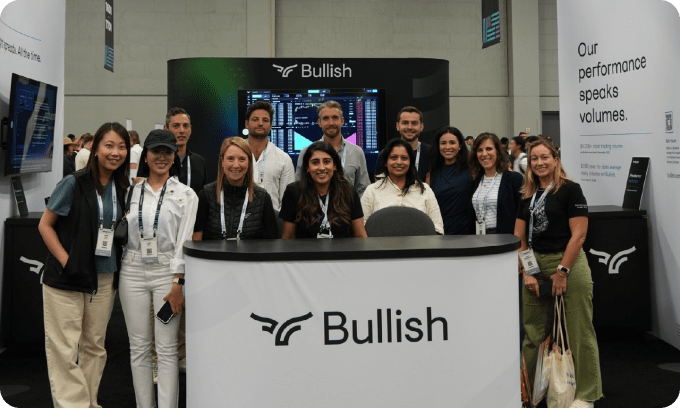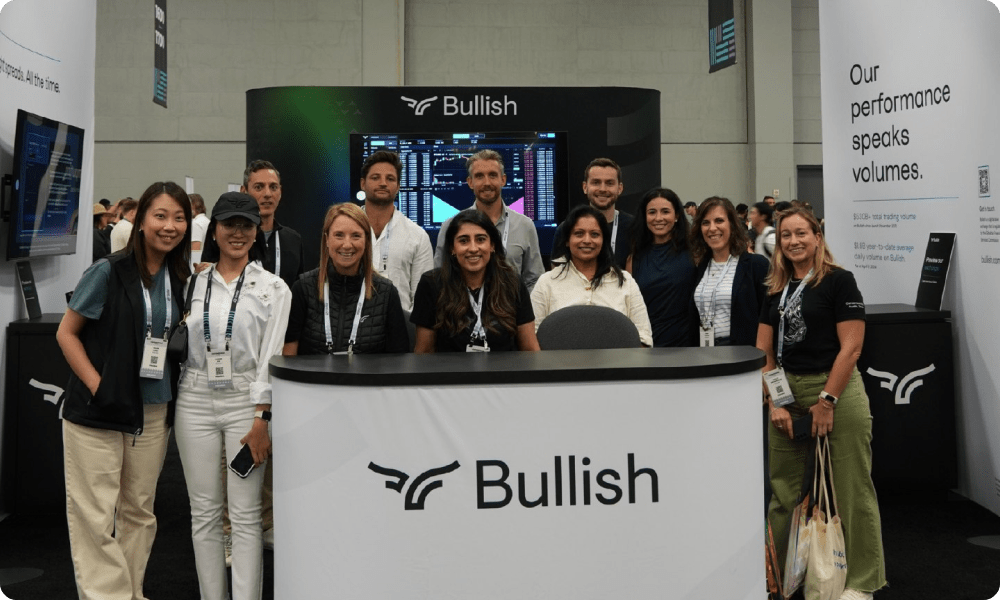Marketplace Regolith
Your investment opportunities

Bullish
Crypto exchange & analytics
Updated on 23 Dec 2025

Thomas Farley
CEO
$200,000
Allocation
$1,000
Price
$1,000
Min. investment
.png?v1766945343)
Updated on 23 Dec 2025
Why Bullish Is a Must-Have in Your Portfolio
The leader in institutional crypto markets with a unique ecosystem: Bullish Exchange + CoinDesk media group + CCData analytics platform. Transparent trading and deep liquidity through a combination of centralized infrastructure and DeFi-inspired AMM mechanisms.
Global regulatory footprint — licenses in the U.S., Germany, Hong Kong, and Gibraltar.
Explosive growth in metrics: trading volume up 78% YoY; average daily volume of $2.55B.
Strong demand — both the IPO price range and offering size have been raised due to oversubscription.
Exclusive Participation Terms
The Bullish IPO book is oversubscribed multiple times, with demand far exceeding supply. Application and funding deadline: Today, by 6:00 PM (UAE time).
Bullish offers a rare opportunity to enter an institutional-grade crypto company backed by BlackRock and ARK Invest, at a time when sector interest is at a peak. Oversubscription of the book and an increased price range signal overwhelming demand.
Key highlights and investors
BlackRock — already committed to a $200M purchase
ARK Investment Management (Cathie Wood) — also committed $200M in IPO support
Founders Fund (Peter Thiel) — Bullish is backed by Peter Thiel’s venture capital firm
Institutional focus: Licensed in the U.S., Germany, Hong Kong, and Gibraltar
Ecosystem: Bullish Exchange + CoinDesk media group + CCData analytics platform
Strong metrics: +78% YoY growth in trading volume; average daily volume of $2.55B
Demand exceeds supply: IPO size increased and price range raised due to oversubscription
The Founding and Growth of Bullish
In 2020, when the digital asset world was boiling with contradictions and change, a man appeared on the horizon who already understood how markets evolve — Thomas Farley, former President of the New York Stock Exchange.
He foresaw that cryptocurrency was entering a new era, where the main players would no longer be anonymous traders on forums but institutional investors demanding transparency, deep liquidity, and strict regulatory compliance. Farley assembled a team of Wall Street veterans and blockchain pioneers. Together, they envisioned a new kind of exchange — Bullish: with infrastructure capable of handling billions in trading volume and mechanisms borrowed from the best decentralized platforms. Investments came from leading venture funds, including Peter Thiel’s Founders Fund, soon joined by giants like BlackRock and ARK Invest, who recognized the potential in blending traditional finance with crypto innovation.



In 2023, Bullish made a strategic move by acquiring CoinDesk, a leading media and analytics platform in the industry. This gave the company not only a voice in the digital asset world but also the ability to shape the market’s agenda. In just a few years, Bullish progressed from a bold idea on paper to one of the largest players in the cryptocurrency world, facilitating trades exceeding $1.25 trillion.
Today, Bullish is going public on the New York Stock Exchange, ready to offer the market what its founder envisioned: a transparent, regulated, and powerful infrastructure for a new financial era.
Frequently Asked Questions (FAQ)
— What is an IPO?
An IPO (Initial Public Offering) is when a private company lists its shares on a stock exchange for the first time to raise capital from investors. From that point onward, the company’s shares can be freely bought and sold on the open market.
— Where are IPOs conducted?
IPOs take place on the world’s largest stock exchanges. In the U.S., the primary venues are the NYSE (New York Stock Exchange) and NASDAQ. Once a company goes public, its shares are freely traded on these exchanges, and the market price is established after the offering.
— What is allocation?
Allocation (from “allocation” — distribution) refers to the process of distributing resources, assets, or capital for maximum efficiency. In investing, allocation usually means distributing the available amount of shares among investors in an IPO or private placement.
— How much allocation does an investor receive?
The allocation size depends on the specific deal and typically ranges from 2% to 30% of the submitted order. Information about the actual allocation becomes available roughly one day before the offering, approximately six hours prior to the trade.
Example — Bullish IPO:
An investor placed an order for $10,000. The allocation was 29.6%, meaning $2,960 was invested in the IPO. The remaining $7,040, including the purchase commission, was refunded to the balance and became available for withdrawal.
— Why do companies go public?
To raise growth capital, increase brand visibility, and provide early investors and employees with an opportunity to sell part of their shares.
— How is participating in an IPO different from buying shares on the exchange?
When you participate in an IPO, you buy shares before they start trading publicly. This provides an opportunity to purchase at the fixed offering price but also carries the risk that the price may drop once trading begins.
— What do I get by participating in an IPO through Regolith?
You become an investor in the company at the IPO stage via our U.S. partner infrastructure. After the transaction is completed and the lock-up period expires, profits from the share sale are distributed among investors proportionally to their stake in the deal.
— What is a lock-up period and how long does it last?
A lock-up period is a timeframe set by the issuer and underwriters during which shares cannot be sold. For IPOs offered through our platform, this period is 93 days. Once it ends, the shares are sold on the exchange and proceeds are distributed among investors.
— How is participating through the platform different from buying shares independently?
To buy independently, you would need access to a U.S. broker, a significant investment amount, and approval from underwriters. The platform pools capital from investors, providing access to IPOs that are otherwise unavailable to most individuals.
— Through whom is IPO participation carried out?
We operate through a U.S.-based structure that works with a licensed broker in the U.S. Our partner selects promising IPOs and participates in the offering under its own name.
— How is the deal structured legally?
An investor signs an agreement/offer to participate in the investment product. Regolith then transfers funds to its partner entity — Wealthy Labs Limited (the provider), which enters into a forward contract with the broker and executes all operational activities. The provider delivers the financial outcome to Regolith, which then distributes proceeds among investors.
— Is there a minimum investment amount?
Yes. Each IPO has a defined minimum entry threshold, shown on the offering page. On average, Regolith provides access starting from $500.
— Do I receive shares into my personal brokerage account?
No. Shares are purchased and held in the partner’s brokerage account. After the lock-up period, the broker sells the shares and transfers proceeds for distribution among investors.
— Can shares be transferred directly to my brokerage account?
No. Participation is structured via a forward contract with the partner’s brokerage infrastructure. The deal is executed on behalf of the partner, and settlements with investors are carried out through the platform.
— How can I sell my shares after the IPO?
Sales are processed automatically: once the lock-up expires, the partner broker sells the shares on the exchange, and proceeds are distributed proportionally among investors.
— What are the risks of investing in IPOs?
IPOs are high-risk investments. While they may offer high returns, they also carry significant volatility. Share prices on the first trading day — and after the lock-up — can fluctuate sharply. There is a risk that the market price will fall below the offering price. In addition, macroeconomic and sector-specific factors can affect outcomes.
— Can I know in advance how much I will earn?
IPO returns are not guaranteed. The final result depends on the share price at the time of sale after the lock-up, overall market conditions, and the company’s performance.
— How can I verify that Regolith participates in IPOs?
We publish all available deal information in the client dashboard. Additionally, we provide an agreement disclosing the infrastructure used for transactions. Broker and partner documents are not shared, as they contain confidential data protected by contractual obligations.

Thomas Farley
CEO
Details
Ticker
BLSHExchange
NYSEIPO Price Range
$32–33Offering Size
$990MIPO Valuation
~$4.8BShares Offered
30MIPO Date
13 Aug 2025Underwriters
J.P. Morgan, Jefferies, Citi and othersTerms
Lock-up period
93 daysDeal Fee
5%Carried Interest
30%Risk potentinal
Very HighDocuments

Bullish
Crypto exchange & analytics
Updated on 23 Dec 2025

Thomas Farley
CEO
$200,000
Allocation
$1,000
Price
$1,000
Min. investment

 Русский
Русский 















